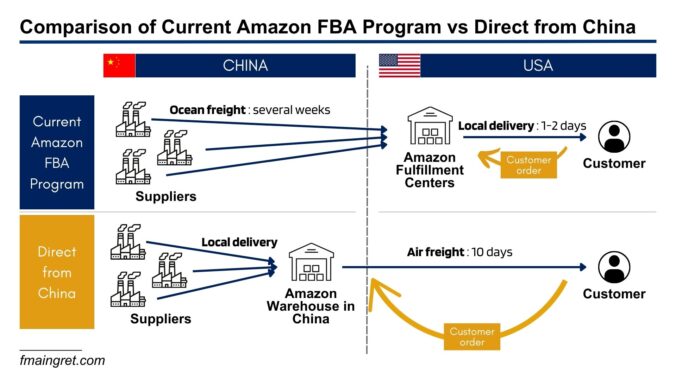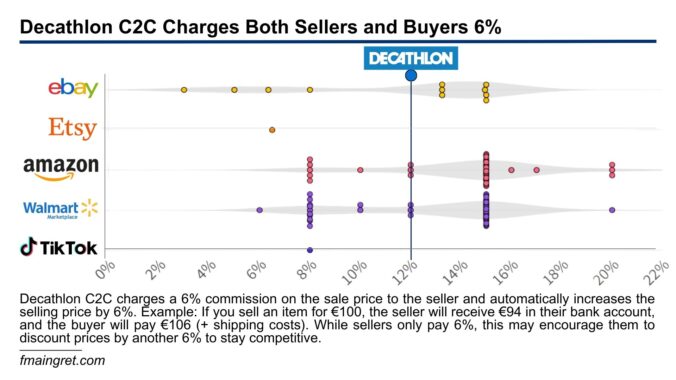Last week, I came across a great article by Spencer Soper in Bloomberg (link below, I recommend reading it) about how Amazon sold a returned used diaper, and hurt an American small business relying on the FBA program. I found that this story is the perfect example of the shit (no pun intended) Amazon sellers have to deal with every day. The process of the incident is complex, with many actors and tasks involved, and I’d like to break it down to identify what went wrong and what could have been done better. Then, I’ll give my opinion on what I think was the main issue here, and how frustrating it can be for millions of sellers.
Continue readingAuthor: Francois Maingret (Page 1 of 11)

Amazon Plans to Facilitate Direct Shipping from China: Are Temu and Amazon Two Sides of the Same Coin?
Right before taking a vacation, I saw the news about Amazon planning to assist sellers based in China to ship directly to US customers, similar to what Temu does. While I recognized the importance of this move, the news didn’t surprise me. It’s been clear that China-based sellers have become a key part of Amazon’s strategy. We’ve seen several moves in the past to help Amazon compete with Temu and Shein, so this isn’t entirely new.
However, this might be Amazon’s boldest move to date. My initial thought was, “Some Amazon sellers are in big trouble.” After discussing this shift, I’d like to reflect on the convergence between Amazon’s and Temu’s strategies and review the potential impact on US-based sellers.
Continue readingAs we approach July, I bet your LinkedIn feed is packed with guides on how to prepare for Amazon Prime Days. “This is the biggest day of the year!” they say. “Make sure you have enough inventory” or “Here’s how to optimize your listings” they’ll advise. While there is often good advice in these posts, the authors assume you are participating in Prime Days. Many entrepreneurs selling on Amazon believe they MUST discount their products during these few days. But should they really?
In this post, I’ll argue that not every business benefits from participating in Prime Days. Low margins, product positioning, brand image, inventory issues—there are many factors impacting a business’s interest in flash sales. So, let’s explore when a business should NOT participate in this event.
Continue readingI can’t help feeling angry when I see people throwing out perfectly fine products just to make room for new stuff. Not that I worry about them making easy money from reselling the items, but because of the waste of resources involved, especially when there are so many online resale platforms available. Many focus on fashion-related items, but we are starting to see more for other products. Only a few days after posting about Shein’s resale product, I read about the sport retailer Decathlon’s new resale platform for their products. And I thought, it is about much more than just pricing. Thinking about it, I can see many more reasons why companies are starting their C2C resale channels.
Continue reading
If you’re reading my content, you know my stance on the fast-fashion industry. Yet, I find it fascinating to observe dynamics between competitors, regulators, and customers. This time, the giant Shein is facing new regulations in the European Union. We can also hear industry experts in the US calling for changes regarding Temu and Shein, for example, on de minimis thresholds. This time, Shein is under scrutiny in the EU, and subject to new regulations. Let’s see what these new regulations are about, and why I think the recent measures Shein took in the EU won’t be enough to make their model more sustainable.
Continue readingAre you tired of hearing about TikTok yet? From articles on how TikTok killed our attention span to the potential security threat leading to a ban in the US, the Chinese social media platform keeps making headlines. We already know about its growing impact on American businesses through its influencers and shopping features. Social commerce is growing year after year, and we can expect the trend to continue following the latest news: TikTok lowers the threshold for content creators to become affiliates. Let’s see what this is about and how it will impact brands and consumers.
Continue readingNote: This is satire, if you’re looking for legitimate business advice, this isn’t the right article for you. This is more of a guide to help aspiring entrepreneurs avoid obvious scams.
In a world where everyone is chasing the next big thing, finding meaning in your work is very important for your well being. What better way to do this than by empowering others with the financial freedom to fulfill their dreams? Instead of just building a billion-dollar business for yourself, why not teach others how to achieve the same success?
It is more than just a job, it is a mission to make the world a better place, one success story at a time. And today, I will give you my secrets to become a business guru in no time.
Continue readingWhen I was a kid, my dad would take me to flea markets and garage sales every other weekend. I loved it because I could always find a cool toy for very little money. A few years later, as a teenager, I started looking for things I could resell for a profit. It was exciting and helped me make a little money to go out with my friends, but I had to stop when I got busy with college.
Fast forward a few years, while the ultra-fast fashion and disposable clothes from Shein often make the headlines in the news, recommerce is bigger than ever. Vinted revenues are growing year after year. Even Tiktok launched a new ‘Preowned Luxury’ category. Last week, eBay, one of the main channels for second-hand items, announced an interesting innovation for their clothing category. I think this is a great opportunity to go over this new feature, and review what the challenges are for small businesses in the pre-owned fashion industry.
Continue reading




